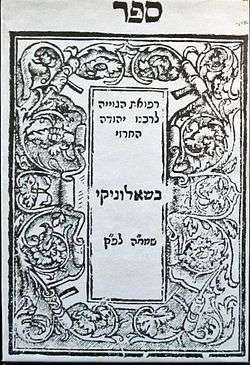Yehuda Alharizi

Yehuda Alharizi, also Judah ben Solomon Harizi or al-Harizi (Hebrew: יהודה בן שלמה אלחריזי, Yehudah ben Shelomo al-Harizi, Arabic: يحيا بن سليمان بن شاؤل أبو زكريا الحريزي اليهودي من أهل طليطلة, Yahya bin Sulaiman bin Sha'ul abu Zakaria al-Harizi al-Yahudi min ahl Tulaitila) was a rabbi, translator, poet and traveller active in Spain in the Middle Ages (1165 in Toledo? – 1225 in Aleppo). He was supported by wealthy patrons, to whom he wrote poems and dedicated compositions.
He was a rationalist, conveying the works of Maimonides and his approach to rationalistic Judaism. He translated Maimonides' Guide for the Perplexed and some of his Commentary on the Mishnah, as well as the Mahbarot Iti'el of the Arab poet al-Hariri, from the Arabic to Hebrew.
Alharizi's poetic translation of the Guide for the Perplexed is considered by many to be more readable than that of Samuel ben Judah ibn Tibbon. However, it has not been very widely used in Jewish scholarship, perhaps because it is less precise. It had some influence in the Christian world due to its translation into Latin.[1]
Alharizi's own works include the "Tahkemoni", composed between 1218 and 1220, in the Arabic form known as maqama. This is written in Hebrew in unmetrical rhymes, in what is commonly termed rhymed prose. It is a series of humorous episodes, witty verses, and quaint applications of Scriptural texts. The episodes are bound together by the presence of the hero and of the narrator, who is also the author. Another collection of his poetry was devoted to preaching ethical self-discipline and fear of heaven.
Harizi undertook long journeys in the lands of the Middle East. His works are suffused with his impressions from these journeys.
He not only brought to perfection the art of applying Hebrew to secular satire, but he was also a brilliant literary critic and his maqama on the Andalusian Hebrew poets is a fruitful source of information.[2]
Literature on Alharizi's influence in the Christian world
- Kluxen, Wolfgang (1951). Untersuchung und Texte zur Geschichte des lateinischen Maimonides. Diss. Köln.
- Kluxen, Wolfgang (1954). "Literargeschichtliches zum lateinischen Moses Maimonides". Recherches de Théologie Ancienne et Médiévale. 21: 23–50. ISSN 1370-7493.
- Kluxen, Wolfgang (1966). "Rabbi Moyses (Maimonides): Liber de uno Deo benedicto". Misc. Med. 4: 167–182.
- Kluxen, Wolfgang (1966). "Die Geschichte des Maimonides im lateinischen Abendland". Misc. Med. 4: 146–166.
- Vajda, George (1960). "Un abregé chrétien du `Guide des égarés´". JAS. 248: 115–136.
- Hasselhoff, Görge K. (2004). Dicit Rabbi Moyses. Studien zum Bild von Moses Maimonides im lateinischen Westen vom 13. bis 15. Jahrhundert. Würzburg: Königshausen & Neumann. ISBN 3-8260-2692-6.
Notes
- ↑ Mirsky, Aharon; Stroll, Avrum (2007). "Al-Harizi, Judah Ben Solomon". In Skolnik, Fred. Encyclopaedia Judaica. Vol. 1: Aa-Alp (2nd ed.). Detroit: Thomson Gale. pp. 655–657 [p. 657]. ISBN 0-02-865929-5.
It was, however, through Al-Harizi's translation that Maimonides' ideas were propagated in the Christian world. An anonymous Latin translation of the Guide, published in Paris by Agostino Giustiniani in 1520, is based on Al-Harizi's translation and was used by the English schoolmen. Al-Harizi's version also served as the basis for Pedro de Toledo's Spanish translation (published by M. Lazar according to the Ms. 10289, B.N. Madrid, in 1989, Culver City, Calif: Labyrinthos).
- ↑ Mirsky, Aharon; Stroll, Avrum (2007). "Al-Harizi, Judah Ben Solomon". In Skolnik, Fred. Encyclopaedia Judaica. Vol. 1: Aa-Alp (2nd ed.). Detroit: Thomson Gale. pp. 655–657 [p. 656]. ISBN 0-02-865929-5.
Apart from its literary merit and brilliant, incisive style, the Tahkemoni also throws valuable light on the state of Hebrew culture of the period, and describes the scholars and leaders of the communities visited by the author. Al-Harizi gives vivid descriptions of the worthies of Toledo, the poets of Thebes, a debate between a Rabbanite and a Karaite, and conditions in Jerusalem. The Tahkemoni also contains critical evaluations of earlier and contemporary poets, although Al-Harizi's appraisal of his contemporaries is not always reliable and occasionally misses their most essential features.
References
- Much of this article was translated from יהודה אלחריזי (Yehuda Alharizi) in the Hebrew-language Wikipedia. Retrieved March 14, 2005. Both articles are licensed under the GNU Free Documentation License, which allows translation with acknowledgement.
- See, on the Tahkemoni,
- Saul Isaak Kaempf: Die ersten Makamen aus dem Tachkemoni des Charisi, Berlin 1845
- Idem: Nicht-andalusische Poesie andalusischer Dichter, Prague 1858.
(In that work a considerable section of the Tahkemoni is translated into German.)

External links
- Al-Ḥarizi, Judah B. Solomon B. Hophni in the Jewish Encyclopedia of 1901-1906
- High-quality scans of Tahkemoni in Hebrew from daat.co.il
- Another scanned edition of Tahkemoni in Hebrew from hebrewbooks.org
- A full translation of Tahkemoni into German from hebrewbooks.org